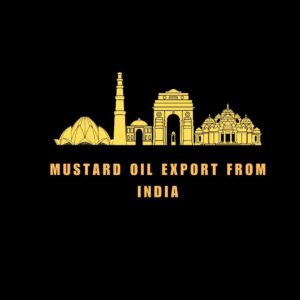
Mustard Oil Export from India
India is one of the largest producers and consumers of mustard oil globally, with its deep-rooted cultural, culinary, and medicinal significance. Over the years, mustard oil has gained popularity in international markets due to its health benefits, unique flavor, and versatile applications. With a growing global demand for natural and healthy oils, mustard oil export from India has become a lucrative business opportunity.
In this blog, we will explore the dynamics of mustard oil exports from India, including market trends, key statistics, export destinations, challenges, and opportunities.

Overview of the Mustard Oil Market in India
India’s mustard oil market is thriving due to its widespread use in cooking, personal care products, and traditional medicine. The market is expected to grow at a compound annual growth rate (CAGR) of 4.2% from 2025 to 2033, reaching USD 1.7 billion by 2033 from USD 1.2 billion in 2024.
Key Drivers of Growth:
-
Health Benefits: Mustard oil is rich in omega-3 fatty acids, antioxidants, and antibacterial properties that make it a preferred choice for health-conscious consumers.
-
Government Initiatives: Policies aimed at increasing oilseed production and achieving self-sufficiency in edible oils have boosted mustard oil availability for both domestic use and export.
-
Rising Global Demand: The growing preference for natural and organic oils in international markets has increased the demand for Indian mustard oil.
Market Trends and Export Potential
Global Demand for Mustard Oil
The global edible oil market has seen a shift toward healthier options like mustard oil due to its unique nutritional profile. Countries in Europe, the Middle East, and Asia-Pacific are key importers of Indian mustard oil.
Export Statistics
-
India exported USD 118.38 thousand worth of mustard oil to France alone in 2023.
-
The Asia-Pacific region is expected to see significant growth in mustard oil consumption, with market revenues projected to reach USD 7.9 billion by 2030.
-
The Middle East & Africa (MEA) region also shows steady growth with a CAGR of 3.6% from 2025 to 2030.
Key Export Destinations for Indian Mustard Oil
-
Europe: Countries like France are major importers due to their preference for high-quality natural oils.
-
Middle East & Africa (MEA): Growing demand for bottled mustard oil makes this region a promising market.
-
Asia-Pacific: Neighboring countries like Bangladesh and Nepal are consistent buyers of Indian mustard oil due to cultural similarities and proximity.
-
North America: Health-conscious consumers are driving demand for Indian-origin mustard oil as an alternative to other cooking oils.
Types of Mustard Oil Exported from India
-
Kachchi Ghani Mustard Oil (Grade I): Cold-pressed oil known for its purity and health benefits; highly sought after in international markets.
-
Refined Mustard Oil: Processed to remove impurities; used widely in cooking and industrial applications.
-
Non-edible Mustard Oil (Grade II): Used in industrial applications such as lubricants and biofuels.
Applications Driving International Demand
Cooking Uses
-
Cooking
-
Frying
-
Salad dressings
Personal Care Products
-
Hair oils
-
Massage oils
-
Skincare products
Industrial Uses
-
Lubricants
-
Biofuels
-
Pharmaceuticals
Challenges in Mustard Oil Export
-
Regulatory Barriers: Different countries have varying standards for edible oils, which can complicate export processes.
-
Competition from Other Oils: Oils like olive oil and sunflower oil dominate certain markets due to established consumer preferences.
-
Supply Chain Issues: Ensuring consistent quality and timely delivery can be challenging due to logistical constraints.
-
Awareness Gap: Limited awareness about the benefits of mustard oil compared to other oils may hinder growth in new markets.
Opportunities for Growth
-
Organic Certification: Exporting organic-certified mustard oil can help tap into premium markets.
-
E-commerce Platforms: Selling through global online marketplaces can expand reach and reduce dependency on traditional distribution channels.
-
Value Addition: Introducing flavored or fortified variants can attract niche consumer segments.
-
Collaborations with Global Brands: Partnering with international food or personal care companies can boost brand visibility.
FAQs About Mustard Oil Export from India
Why is Indian mustard oil popular in global markets?
Indian mustard oil is known for its purity, rich flavor, and health benefits such as being high in omega-3 fatty acids and antioxidants.
What are the key export destinations for Indian mustard oil?
Key export destinations include Europe (e.g., France), Asia-Pacific (e.g., Bangladesh), the Middle East & Africa (MEA), and North America.
What types of mustard oil are exported?
India exports Kachchi Ghani (cold-pressed), refined mustard oil, and non-edible Grade II mustard oil.
How can exporters overcome regulatory challenges?
Exporters should ensure compliance with international food safety standards, secure necessary certifications (e.g., organic or ISO), and work with local distributors familiar with regulations.
What role does e-commerce play in mustard oil exports?
E-commerce platforms enable exporters to reach global customers directly while reducing dependency on intermediaries.
Conclusion
India’s burgeoning mustard oil industry presents immense opportunities for export growth due to its unique health benefits, diverse applications, and rising global demand for natural products. By addressing challenges such as regulatory barriers and leveraging opportunities like organic certification or e-commerce platforms, Indian exporters can strengthen their presence in international markets.
With government initiatives supporting increased production and strategic marketing efforts targeting health-conscious consumers worldwide, the future of Indian mustard oil exports looks promising!
